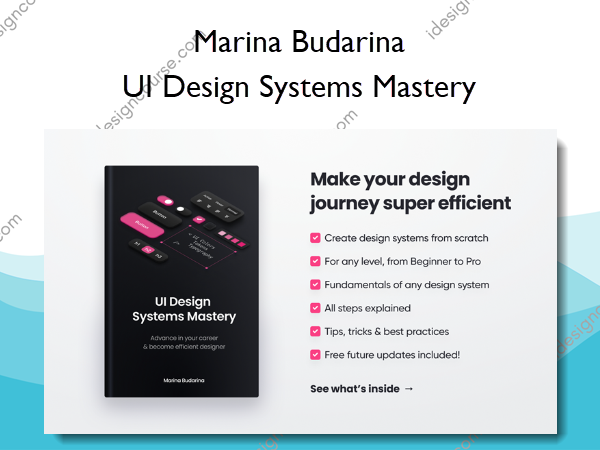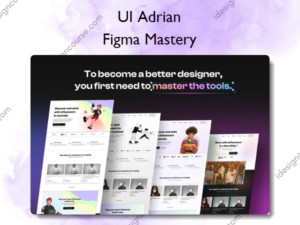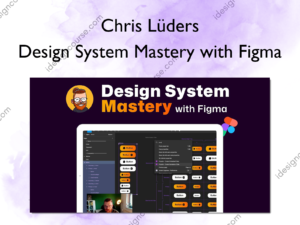UI Design Systems Mastery – Marina Budarina
$49.90 Original price was: $49.90.$17.00Current price is: $17.00.
Description
UI Design Systems Mastery Information
Unlock Your Design Potential and Create Stunning User Interfaces with UI Design Systems Mastery 🚀
What you will achieve on coming out of this e-book:
Expertise in building a design system.
Gain a comprehensive understanding of how to design systems are constructed. Learn key steps, set goals, define problems and principles, and create color, typography, spacing, grid systems, and tokens.
Flexibility in future projects.
Get a step-by-step guide on how to adjust your design system to fit the needs of each project. Streamline your processes and save time by setting up a basic design system for all future projects.
More clients, projects, or even a better job.
Save time and work more efficiently by creating a simple style guide and basic component library. You will attract better clients and more opportunities as your skills and processes improve.
Moreover…
Ideal for solo designers or teams.
Whether you are a single designer or working with others, this guide provides the knowledge to create a design system.
Suitable for Junior designers.
Gain valuable experience and knowledge, regardless of your level of experience.
Focus on real work.
Streamline your processes and avoid tedious steps by setting up a basic design system for all future projects.
Here’s what you’ll learn in UI Design Systems Mastery:
Part 1 – Introduction
In this part, I will tell you about my design journey; share with you some very important ideas and points that helped me to land a job (and will help you)
Part 2 – Design system basics
Here I’ll tell about what a design system is, a little bit of history, Pros & Cons, what types of design systems exist, myths and misunderstandings, and when you need and don’t need it.
Part 3 – Preparation and steps overview
In this part, we will define which steps you should take before creating any design system; will cover the main process you will take when creating any part of your design system.
Part 4 – Foundations
In this part, we will talk about tokens, spacing, colors, typography, and grids. We will cover what each element does, how to create it, how to name and some best practices.
Part 5 – Components, patterns, templates.
Here we will talk about the atomic approach, what components are, what to consider before creating any component, and talk about naming, scaling, and token usage. I’ll explain where to start building a component library and show different methods of creating components in Figma. Then we cover compound components, patterns, templates, and pages, and whether you need them.
Part 6 – Documentation
Here we will cover why we need documentation, in which forms it can exist, which tools you can use, and what should be inside.
Part 7 – Implementation.
Here I’ll show you 3 ways how you can approach design systems: adopt, adapt or create, will provide you step by step guide for each of them and clarify which approach is better for you. I also will provide tips to freelance designers on how they can use design systems to their advantage.
Outro.
Here I’ll tell you goodbye and explain “what’s next” 😉
Who is UI Design Systems Mastery course for?
- Full-time Designers of any level (from junior to senior) – who want to improve their skills and knowledge to get a promotion or a better job
- Freelancers – who want to work faster, impress their clients with a level of professionalism, and go to another level of projects
- Non-designers – who want to break into UI/UX and get a good foundation
- Developers – who want to know how designs and prototypes are meant to be translated into code, speed up the development process and reduce misunderstandings during the handoff.
Managers – who want to understand what a Design System is and the purposes it serves
More courses from the same author: Marina Budarina
Salepage: UI Design Systems Mastery – Marina Budarina
Delivery Policy
When will I receive my course?
You will receive a link to download your course immediately or within 1 to 21 days. It depends on the product you buy, so please read the short description of the product carefully before making a purchase.
How is my course delivered?
We share courses through Google Drive, so once your order is complete, you'll receive an invitation to view the course in your email.
To avoid any delay in delivery, please provide a Google mail and enter your email address correctly in the Checkout Page.
In case you submit a wrong email address, please contact us to resend the course to the correct email.
How do I check status of my order?
Please log in to iDesignCourse account then go to Order Page. You will find all your orders includes number, date, status and total price.
If the status is Processing: Your course is being uploaded. Please be patient and wait for us to complete your order. If your order has multiple courses and one of them has not been updated with the download link, the status of the order is also Processing.
If the status is Completed: Your course is ready for immediate download. Click "VIEW" to view details and download the course.
Where can I find my course?
Once your order is complete, a link to download the course will automatically be sent to your email.
You can also get the download link by logging into your iDesignCourse account then going to Downloads Page.










